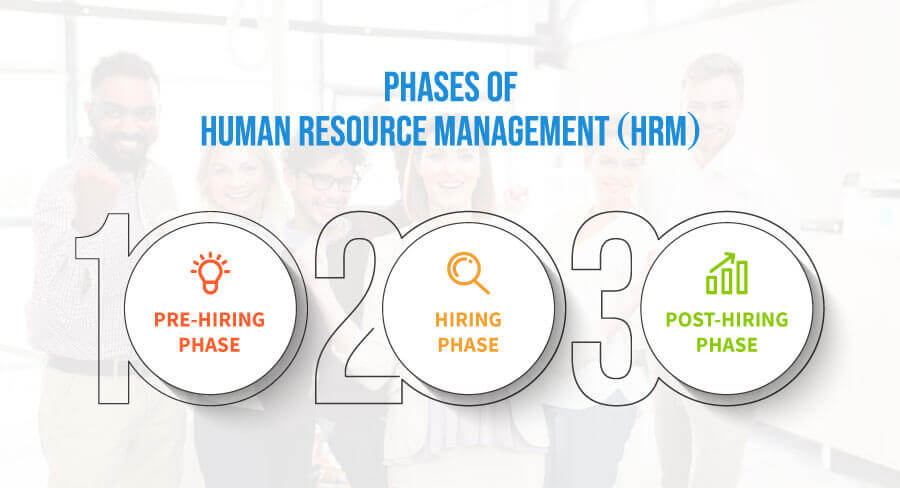Effective 3 Phases of Human Resource Management (HRM)
Human resources are valuable assets of businesses and are managed through a wide range of informal and formal systems in an organization. The responsibilities of a human resource manager fall into three major areas, for example, staffing, employee compensation and benefits, and defining or designing work. To put it simply, the purpose of human resources management is to maximize organizational productivity by making employees as effective as possible. However, there are tried to give answers of what are the three phases of human resource management with some relevant examples.
What are the Three Phases of Human Resource Management (HRM)
Human resource management has phases of practicality that must be followed through to ensure its proper functioning. The phases of human resource management are classified into three types. The next few paragraphs describe the three phases of this process.

1. Pre-Hiring Phase of HRM
The major HRM activities in the pre-hiring phases are human resource planning and job analysis. These activities from the cornerstone upon which other HRM practices are birth human resource planning helps managers to anticipate and meet changing needs related to the acquisition, deployment, and utilization of employees in an organization. The organization first develops a strategic plan, which is considered an overall plan. Then, try to make a forecast based on the required demand and supply. Through this, the overall plan is sorted so that the right number and type of employees can be arranged. Such systematic recruitment, selection, and training strategies plan are formulated.
For example, the following year, 15 additional engineers were needed for a firm by the firm’s HR officials. In this case, the firm hires people who have just completed engineering from the institution to fill such positions. We call them fresher’s. Since the demand for these heads is considered high, the firm decides to start recruiting on campus from the beginning of the campus year so that other companies do not snatch the best candidates.
Job analysis refers to a specific process whose job is to collect, document, and analyze all relevant information. The analysis specifies what each worker does, the work conditions, and the worker qualifications necessary to perform the job successfully. The job analysis information is issued to plan and coordinate nearly all HRM practices, including:
- Determining job qualifications for recruitment purposes
- Selecting the most appropriate section techniques
- Developing performance appraisal rating forms
- Helping to finalize pay rates
- Setting performance standards for productivity improvement programs
For instance, an organization may choose to use a mechanical aptitude test as a screening device for applicants because a job analysis showed that mechanical aptitude is a relevant job skill. Or, a company may raise the salary of one of its employees because the nature of his work recently changed and is now more demanding.
2. Hiring Phase of HRM
Staffing is the term used in human resource management for the process of hiring employees. Staffing involves practices used by organizations to find and hire new employees. Organizations use recruitment to locate candidates and attract them to jobs. They may recruit internally or externally. The aim of recruitment practices is to quickly and cost-effectively find candidates who will work well at the organization. Interviewing, rating, and selecting the best candidates are some of the most important parts of the hiring process. In order for selection processes to be successful, they must be legal and technically sound, as well as accurate. This will ensure that the right people are hired for the right jobs.
3. Post-Hiring Phase of HRM
When training and development are provided to employees, it helps them improve their existing skills and learn new ones that are needed for ensuring a smooth work process. Training and development practices are designed to improve organizational performance by enhancing the knowledge and skills level of employees. A firm must first determine its training needs and then select or develop training programs to meet these needs. Workers also need to be given an opportunity to apply their skills and knowledge on the job.
Performance appraisals provide a way for organizations to evaluate employee performance, communicate those evaluations to employees, and motivate employees to continue working in ways that are productive or to adopt changes that are necessary. Management also may use performance appraisal as a tool for making HRM-related decisions, such as promotions, demotion, discharge, and pay rates.
Compensation entails pay and benefits. Pay refers to the salary that the employees earn, while benefits are the extras provided by the company to employees, such as health insurance or a discount at their store. The aim of compensation practices is to help the organization establish and maintain a competent and loyal workforce at an affordable cost.
Productivity improvement programs enhance job behavior to rewards. Rewards can come in a number of forms, from financial bonuses and pay raises to an improved sense of job satisfaction. These programs can be used to encourage employees to engage in behaviors that help increase productivity and profits.



